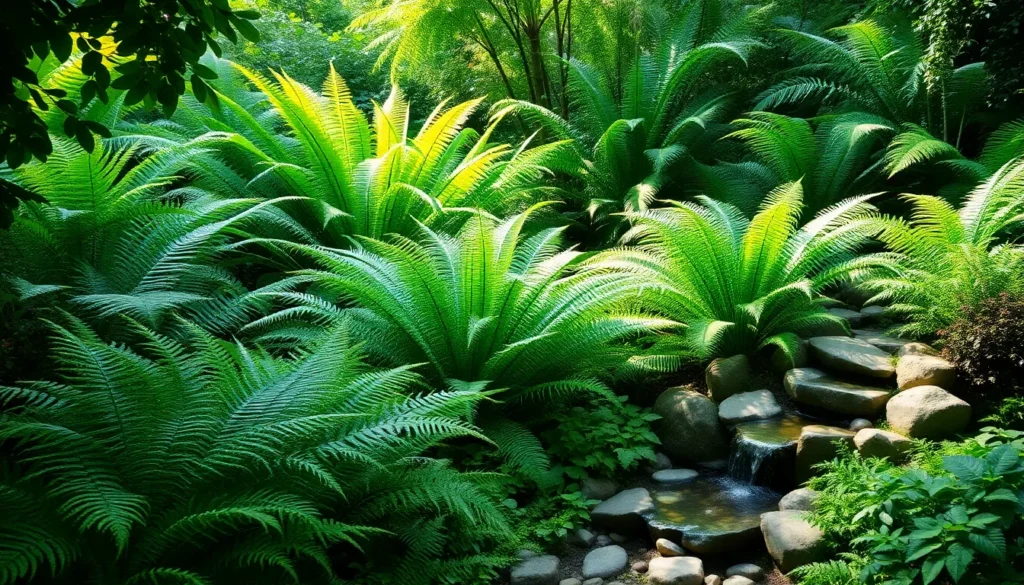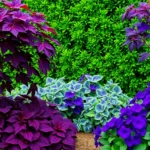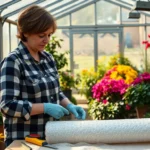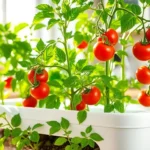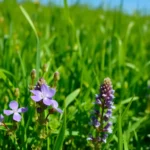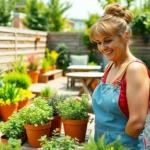We’ve all walked through enchanted forests where delicate ferns create magical green carpets beneath towering trees. That same mystical beauty can transform your outdoor space into a lush sanctuary that thrives in shaded areas where other plants struggle.
Fern gardens offer the perfect solution for those challenging spots in your yard – under trees, alongside north-facing walls, or in naturally damp corners. These ancient plants bring prehistoric charm to modern landscapes while requiring minimal maintenance once established. From dramatic tree ferns that create tropical vibes to delicate maidenhair varieties that add ethereal texture, there’s a fern for every garden style and climate.
We’ll explore creative ways to design stunning fern gardens that turn your shaded spaces into showstoppers. Whether you’re working with a small corner or planning an entire woodland retreat, these ideas will help you create a verdant oasis that’s both low-maintenance and absolutely captivating.
Create a Shaded Woodland Fern Garden
Woodland fern gardens capture nature’s serene beauty while providing the perfect solution for challenging shaded areas. We can transform any dim corner into a thriving network that mirrors the forest floor’s natural elegance.
Choose Native Woodland Fern Species
Native ferns adapt effortlessly to local conditions and require minimal care once established. We recommend selecting Christmas ferns, royal ferns, and lady ferns for their reliability and stunning foliage. These species naturally complement each other while providing year-round interest in woodland settings.
Regional varieties offer the best success rates for long-term garden health. Eastern gardeners should consider cinnamon ferns and interrupted ferns for their dramatic height and texture. Western regions benefit from sword ferns and deer ferns that handle varying moisture levels with ease.
Soil preferences vary among woodland fern species, so we group plants with similar needs together. Moisture-loving ferns like royal ferns thrive near water features or naturally damp areas. Drier woodland species such as Christmas ferns excel in well-draining locations under tree canopies.
Design Natural Pathways Through Fern Clusters
Winding paths create intimate experiences while protecting delicate fern fronds from foot traffic. We use natural materials like wood chips, pine needles, or flat stones to maintain the woodland aesthetic. These organic pathways blend seamlessly with the forest floor appearance.
Strategic placement of stepping stones guides visitors through prime viewing areas without disturbing established plantings. Curved routes feel more natural than straight lines and encourage slower movement through the garden space. Width variations accommodate both casual strolls and maintenance access to planted areas.
Mulched corridors between fern groupings provide clear boundaries while suppressing weeds naturally. We apply organic mulch materials that decompose gradually and enrich the soil over time. This approach reduces maintenance requirements while improving the overall woodland garden appearance.
Layer Different Fern Heights for Visual Interest
Tall backdrop ferns create dramatic structure and define garden boundaries effectively. We position ostrich ferns and royal ferns toward the rear of planting areas where their impressive height commands attention. These towering specimens reach 4-6 feet and provide excellent screening for unsightly areas.
Medium-height ferns fill the middle ground and bridge the gap between tall and low-growing varieties. Lady ferns and wood ferns work perfectly at 2-3 feet tall, creating depth without blocking shorter specimens. Their graceful arching fronds add movement and texture to the woodland composition.
Ground-level ferns complete the layered effect and carpet bare soil areas beautifully. We use sensitive ferns and maidenhair ferns as living mulch that spreads naturally over time. These low-growing varieties soften pathway edges and create seamless transitions between planted and natural areas.
Design a Modern Minimalist Fern Display
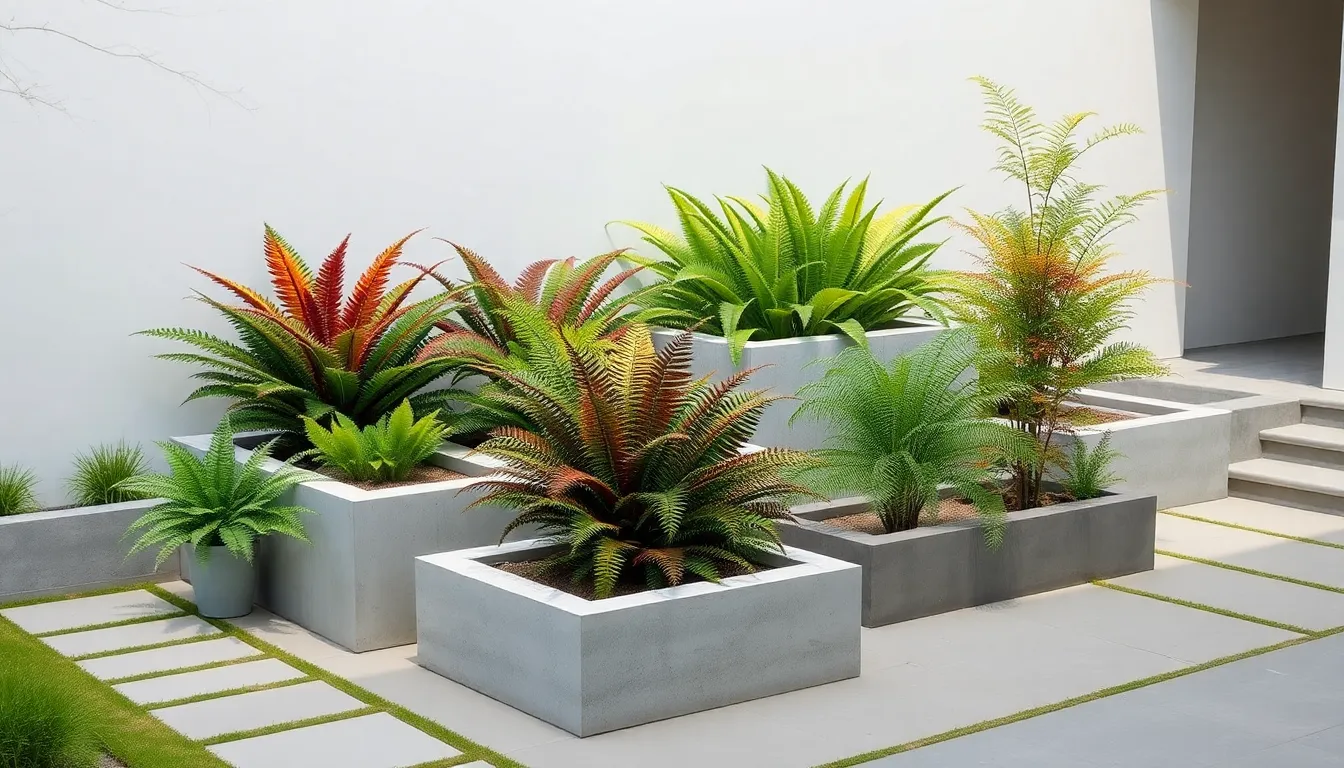
Creating a contemporary fern display requires careful attention to simplicity and structure. We’ll focus on three key elements that transform traditional fern gardens into sleek, modern landscapes.
Select Architectural Fern Varieties
Japanese Painted Fern (Athyrium niponicum) stands out as our top choice for minimalist displays with its striking silvery fronds and clean structure. This variety offers exceptional textural contrast while maintaining the architectural qualities essential for modern design.
Autumn Fern (Dryopteris erythrosora) provides year-round visual interest with bronze emerging fronds that mature to deep green. We recommend this species for its strong silhouette and ability to create vertical focal points without overwhelming the space.
Tree Ferns (Dicksonia or Cyathea species) serve as dramatic centerpieces in larger minimalist gardens. These specimens deliver impressive height and sculptural presence that anchors contemporary outdoor spaces.
Group these varieties in clusters of three to five plants, mixing different species for color variation including silvery, bronze, and deep green hues. Avoid overcrowding by allowing each plant adequate space to showcase its natural form and architectural beauty.
Use Clean Lines and Geometric Planters
Concrete planters in square or rectangular shapes create the foundation for our minimalist fern displays. We choose neutral tones like gray, black, or white to enhance the natural beauty of the ferns without competing for attention.
Stone containers offer durability and timeless appeal while maintaining the clean aesthetic we’re aiming for. Select cylindrical or geometric designs that complement your space’s existing architecture.
Matte metal planters provide contemporary sophistication and work particularly well for indoor minimalist displays. These materials resist weathering while delivering the sleek appearance that defines modern design.
Vary planter heights to create layered displays that add depth and dimension without cluttering the space. Position taller containers toward the back and shorter ones in front for optimal visual flow.
Incorporate Contemporary Hardscaping Elements
Smooth pavers create defined pathways that guide the eye through your minimalist fern display. We use materials with crisp lines to reinforce the modern theme and provide structural contrast to the organic fern shapes.
Low retaining walls made from contemporary materials help organize the space while maintaining clean sight lines. These elements work particularly well in outdoor shade gardens where ferns serve as the main feature.
Gravel pathways offer low maintenance answers that complement minimalist design principles. Choose uniform gravel sizes and neutral colors that won’t distract from the fern displays.
Fill gaps between planters and hardscaping with low maintenance ground covers or mosses that complement the ferns without competing for attention. This approach maintains the uncluttered appearance essential to minimalist design while creating visual cohesion throughout the display.
Build a Tropical Fern Paradise
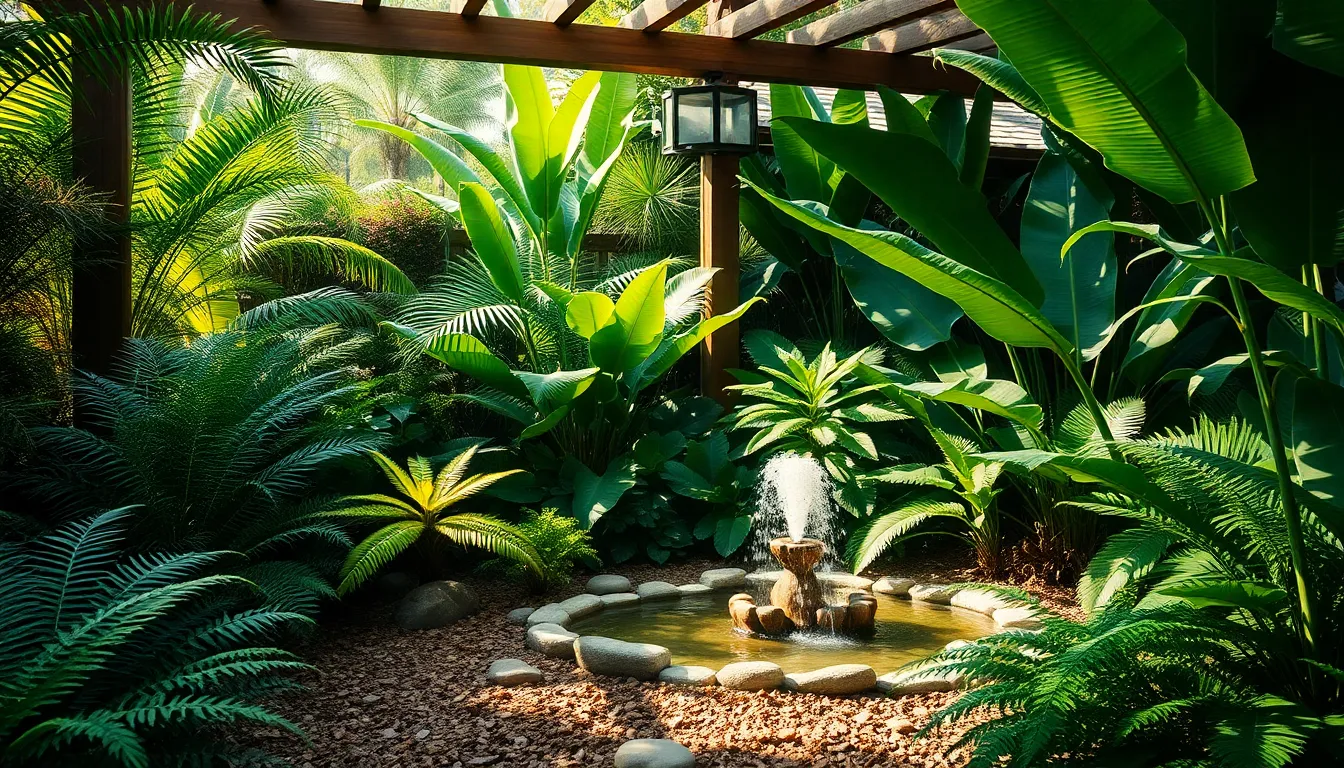
Transform your garden into an exotic tropical haven where lush ferns create a stunning rainforest atmosphere. We’ll show you how to achieve this vibrant look using the right species and design elements.
Choose Heat-Loving Fern Species
Maidenhair ferns serve as perfect centerpieces for tropical fern gardens with their delicate, fan-shaped fronds that dance in gentle breezes. Boston ferns provide exceptional fullness and can tolerate warmer temperatures while maintaining their lush green appearance throughout the growing season. Royal ferns add dramatic height and texture with their large, compound leaves that create impressive focal points in any tropical display.
Tree ferns establish instant tropical drama with their towering presence and umbrella-like canopies that provide natural shade for smaller species below. Staghorn ferns offer unique architectural interest when mounted on tree trunks or walls, creating living sculptures that capture the exotic essence of tropical forests. Bird’s nest ferns contribute glossy, broad leaves that catch and reflect light beautifully in shaded tropical garden spaces.
Create Humid Microclimates
Organic mulching retains essential soil moisture while reducing water evaporation that tropical ferns desperately need to thrive. We recommend using shredded bark, leaf mold, or coconut coir to maintain consistent humidity levels around your fern plantings. Water features like small ponds or fountains increase ambient humidity while creating soothing sounds that enhance the tropical garden experience.
Shade structures using pergolas or arbors help maintain the humid conditions that tropical ferns require for optimal growth. Misting systems installed under these structures provide additional moisture during dry periods, mimicking the natural rainfall patterns of tropical rainforests. Strategic placement of large rocks or decorative stones creates natural water collection points that slowly release moisture into the surrounding air.
Add Complementary Tropical Plants
Elephant Ear plants provide dramatic backdrop foliage with their massive, heart-shaped leaves that create stunning contrasts against delicate fern fronds. Banana plants contribute tropical authenticity with their broad leaves and potential for edible fruit production in suitable climates. Begonias offer colorful blooms that brighten shaded areas while maintaining the same moisture requirements as most tropical ferns.
Flowering climbers like Clematis and Honeysuckle add vertical interest and fragrance to tropical fern gardens when trained on trellises or pergolas. Hostas contribute varied leaf textures and colors that complement fern plantings while providing excellent ground coverage in shaded areas. Dense container plantings create versatile arrangements that can be moved seasonally to maintain optimal growing conditions for both ferns and companion plants.
Establish a Rock Garden Fern Feature
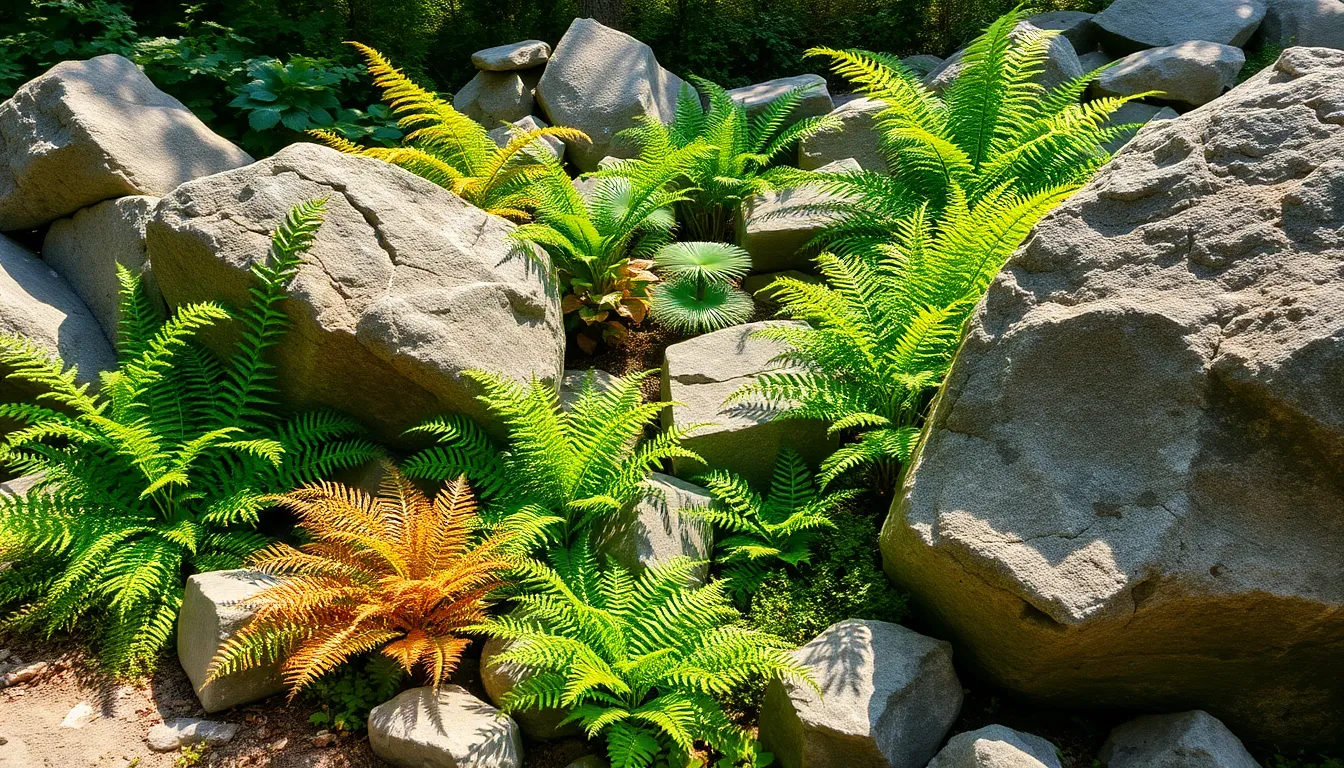
Rock gardens paired with ferns create stunning natural landscapes that celebrate the beauty of stone and foliage together. We’ll transform your outdoor space into a dramatic focal point that requires minimal maintenance while providing year-round visual interest.
Select Rock-Dwelling Fern Varieties
Autumn Ferns thrive naturally in rocky environments and offer bronze-colored fronds that transition to deep green throughout the growing season. We recommend these hardy specimens for their exceptional adaptability to stone gardens and their ability to withstand varying moisture levels.
Lady Ferns provide delicate, lacy foliage that creates beautiful contrast against rough stone surfaces. These varieties grow well in rock crevices and maintain their elegant appearance from spring through fall.
Christmas Ferns deliver evergreen structure to rock gardens and remain attractive during winter months when deciduous plants fade. We suggest positioning these ferns near larger boulders where their upright growth habit creates dramatic vertical lines.
Consider each variety’s growth patterns when making selections. Creeping ferns like Wild Ginger spread horizontally between rocks, while upright varieties such as Royal Ferns add height and architectural interest to your stone feature.
Position Stones for Optimal Drainage
Strategic rock placement prevents waterlogged conditions that damage fern root systems. We arrange larger boulders to create natural slopes that direct excess water away from planting areas while maintaining soil moisture for healthy growth.
Gravel layers beneath and around stone installations improve drainage significantly. Small pebbles fill spaces between larger rocks and create stable growing conditions that ferns prefer.
Tilted stone positioning allows rainwater to flow naturally toward fern plantings without creating standing water. We angle flat stones slightly to guide moisture into soil pockets where roots can access it gradually.
Underground drainage becomes crucial in heavy clay soils. Installing a gravel foundation before placing rocks ensures proper water movement and prevents root rot that commonly affects ferns in poorly drained locations.
Create Crevice Planting Opportunities
Gap formation between rocks provides natural planting pockets that protect fern crowns from harsh weather conditions. We position stones to leave 6-12 inch spaces where soil can accumulate and support healthy root development.
Soil filling in rock crevices requires well-draining, organic-rich mixtures that retain moisture without becoming waterlogged. Combining compost with coarse sand creates ideal growing conditions for most rock garden ferns.
Vertical planting in stone walls adds dimension to your fern feature and maximizes growing space in compact areas. Small fern varieties establish successfully in narrow crevices when provided with adequate soil depth.
Natural integration occurs when ferns self-seed in rock gaps, creating authentic woodland appearances over time. We encourage this process by allowing mature ferns to reproduce naturally while managing unwanted seedlings in inappropriate locations.
Install a Vertical Fern Wall Garden
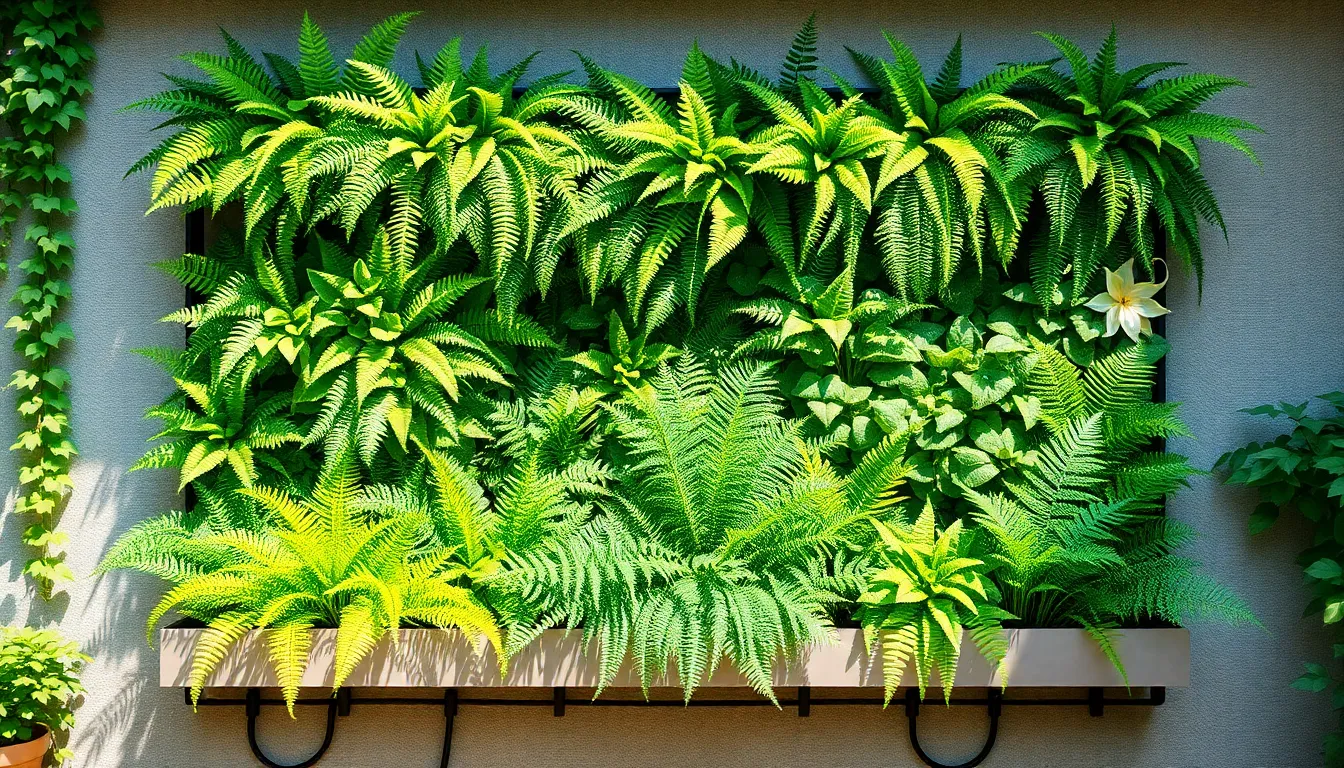
Vertical fern wall gardens maximize space while adding dramatic greenery to any area. We can transform unused wall space into living art that showcases the natural beauty of ferns in a striking architectural display.
Choose Compact Fern Species for Wall Mounting
Maidenhair Ferns offer delicate, lacy foliage that thrives in vertical wall systems without overwhelming the structure. Their compact growth habit makes them perfect for modular planter boxes where space efficiency matters most.
Hart’s Tongue Ferns provide bold, architectural leaves that create stunning visual contrast against wall surfaces. These species resist sprawling growth patterns that could compromise the wall garden’s neat appearance.
Boston Ferns deliver classic cascading fronds that soften the geometric lines of vertical installations. We recommend selecting smaller cultivars that won’t outgrow their designated planter spaces within the first growing season.
Design Proper Irrigation Systems
Drip irrigation systems deliver water directly to fern roots while preventing wasteful runoff down the wall surface. Installing individual drip emitters for each planter box ensures consistent moisture levels without oversaturating any single plant.
Moisture retention materials like coconut coir or sphagnum moss help maintain the humid conditions ferns require between watering cycles. We layer these materials in the bottom third of each planter to create natural water reservoirs.
Drainage considerations prevent root rot by allowing excess water to escape through the bottom of each planter box. Installing small drainage holes with mesh covers keeps soil in place while permitting proper water flow.
Layer Ferns by Light Requirements
Shade loving varieties occupy the lower sections of our vertical wall where building shadows or overhanging structures block direct sunlight. Christmas Ferns and Lady Ferns excel in these dimmer conditions while maintaining healthy growth rates.
Partial shade species fill the middle tiers where filtered light creates ideal growing conditions throughout most daylight hours. Japanese Painted Ferns and Royal Ferns showcase their colorful foliage best in these moderate light zones.
Light tolerant ferns claim the upper portions of the wall installation where morning sun exposure provides the energy they need for robust development. Tree Ferns and Autumn Ferns handle these brighter conditions while still benefiting from afternoon shade protection.
Construct a Water Feature Fern Garden
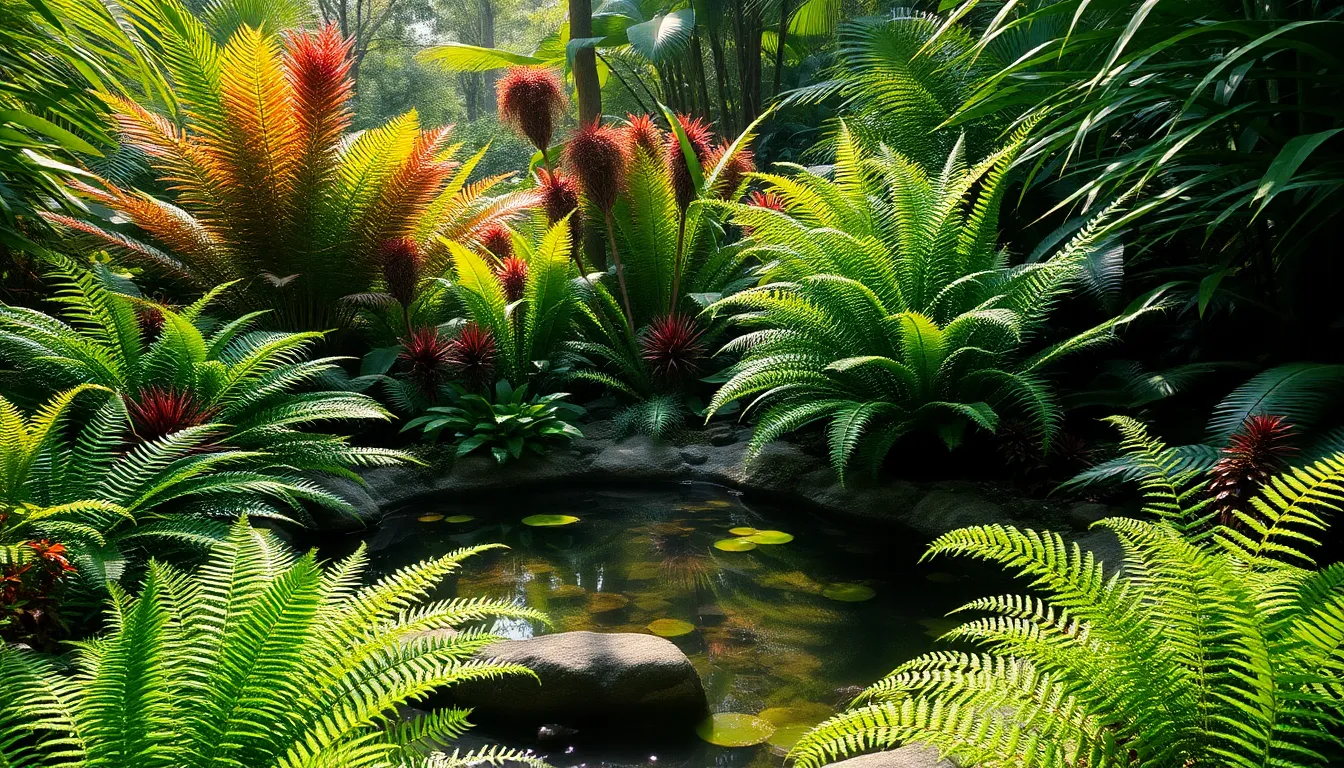
Water features transform ordinary fern gardens into mesmerizing landscapes that capture moisture and create the perfect environment for these humidity-loving plants. We’ll show you how to combine ponds, streams, or rain gardens with carefully selected ferns to achieve maximum visual impact.
Select Moisture-Loving Fern Species
Autumn Fern (Dryopteris erythrosora) stands out as our top choice for water feature gardens with its vibrant bronze-to-green color transformation throughout the growing season. These hardy perennials thrive in consistently moist soil and can tolerate both partial sun and full shade conditions.
Ostrich Fern (Matteuccia struthiopteris) creates dramatic vertical statements near pond edges with its towering 4-6 foot fronds that resemble elegant plumes. Native to wetland areas, this species naturally gravitates toward water sources and spreads through underground rhizomes.
Lady Fern (Athyrium filix-femina) offers delicate, lacy foliage that softens hard water feature edges while maintaining excellent moisture tolerance. We recommend this versatile species for gardeners seeking refined texture rather than bold architectural presence.
Royal Fern (Osmunda regalis) delivers exceptional performance in boggy conditions with its unique flowering spikes that emerge bronze before turning golden-brown. This moisture-dependent variety can handle full sun exposure when planted directly in saturated soil.
Position Ferns Around Pond Edges
Strategic placement around pond perimeters creates natural transitions between water and garden spaces while ensuring optimal growing conditions. We position larger species like Ostrich Ferns 2-3 feet from water edges to prevent crowding while maintaining visual connection.
Layered arrangements work best when we place taller ferns as background anchors and shorter varieties as foreground accents. This technique guides the eye naturally from water surface to garden interior while maximizing the moisture benefits radiating from pond edges.
Shade considerations require careful attention since most water features receive varying light throughout the day. We plant shade-loving varieties on the north side of ponds and more sun-tolerant species where morning or afternoon light reaches the planting area.
Root protection becomes critical near water features where soil stays consistently saturated. We elevate fern crowns slightly above the water table using mounded planting techniques to prevent crown rot while maintaining moisture access.
Create Bog Garden Sections
Bog conditions replicate natural wetland environments using peat moss, compost, and sand mixtures that retain moisture without becoming waterlogged. We excavate areas 12-18 inches deep and line them with punctured plastic to control drainage rates.
Plant combinations enhance bog sections when we pair ferns with moisture-loving companions like marsh marigold, cardinal flower, and giant rhubarb. These partnerships create diverse textures while maintaining consistent water requirements across the planting area.
Moisture management requires installing simple irrigation systems or connecting bog sections to water feature overflow systems. We use soaker hoses buried 4-6 inches deep to maintain consistent soil moisture without surface water accumulation.
Seasonal interest develops through careful species selection that provides year-round appeal in bog environments. We combine evergreen Christmas Ferns with deciduous varieties like Cinnamon Fern to ensure continuous visual impact throughout changing seasons.
Plant a Container Fern Garden Collection
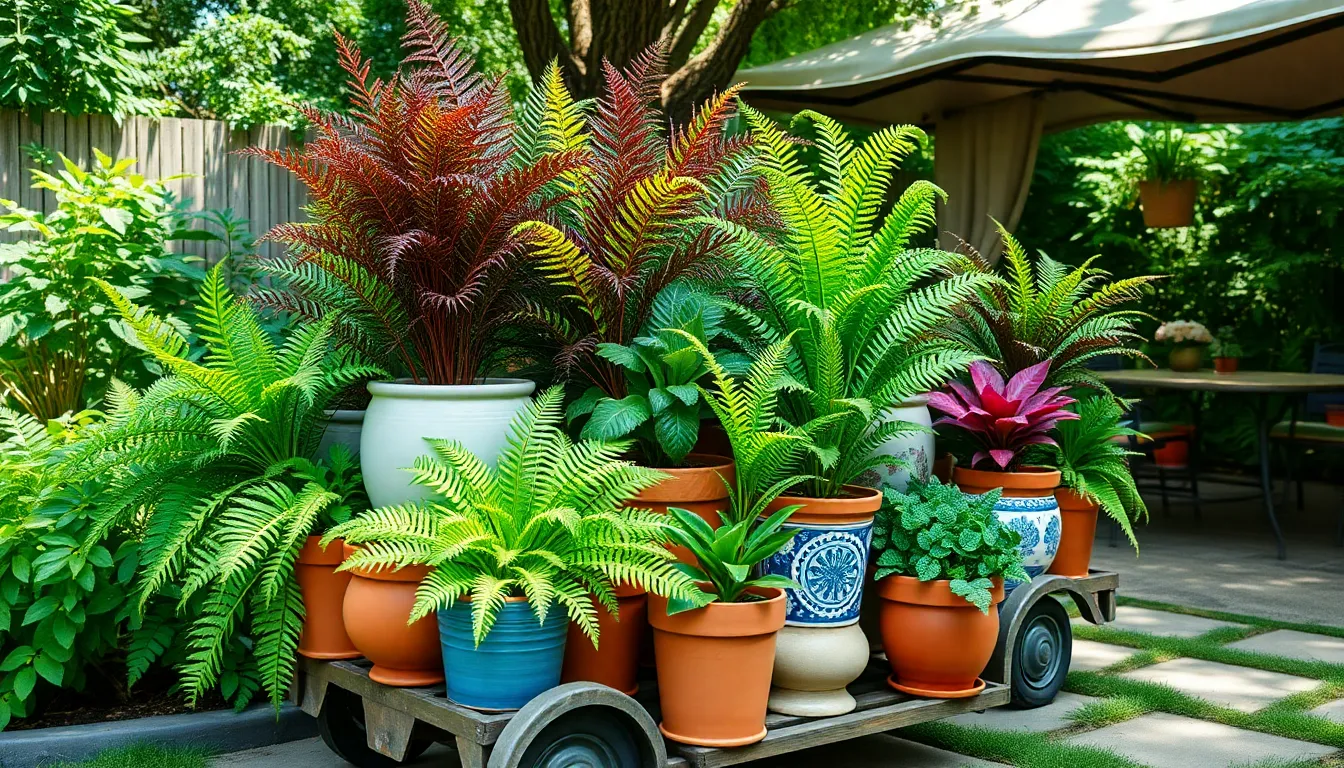
Creating a portable fern garden gives us the freedom to move our lush displays wherever they’re needed most. Container gardening lets us enjoy these elegant plants even in challenging spaces or changing seasons.
Choose Appropriate Pot Sizes and Materials
Selecting properly sized containers ensures our ferns have room to flourish. We recommend using 12-inch pots for small fern collections, though larger specimens may need 16-18 inch containers to accommodate their spreading root systems. Terra cotta pots provide excellent moisture retention while allowing roots to breathe naturally.
Ceramic containers offer superior aesthetic appeal for decorative displays. These materials maintain consistent soil moisture levels that ferns crave while complementing various garden styles. Wooden planters work exceptionally well for rustic settings and provide natural insulation for root systems.
Drainage holes remain essential regardless of material choice. We ensure every container has adequate drainage to prevent waterlogged conditions that can damage delicate fern roots.
Group Ferns by Care Requirements
Pairing ferns with similar light needs simplifies our maintenance routine significantly. We place shade loving varieties like ‘Brilliance’ autumn fern (Dryopteris erythrosora ‘Brilliance’) and Japanese painted fern (Athyrium niponicum var. pictum) together in our shadiest locations.
Moisture requirements should guide our container groupings as well. Ferns that prefer consistently moist soil work best when clustered together, allowing us to water efficiently without overwatering drought tolerant companions.
Combining ferns with complementary plants creates stunning color diversity. We pair our fern collections with begonias, fuchsias, and impatiens to add vibrant blooms while maintaining similar care requirements throughout the growing season.
Design Portable Shade Answers
Creating movable shade structures gives us flexibility in challenging locations. We use umbrellas, gazebos, or lightweight arbors to provide instant shade coverage that can be adjusted throughout the day as sun patterns change.
Strategic container placement maximizes existing natural shade resources. We position our fern collections under established trees or near building overhangs where consistent shade already exists without additional infrastructure.
Wheeled plant caddies make repositioning heavy containers effortless. These accessories let us move entire fern displays to follow optimal growing conditions or bring them indoors during harsh weather periods.
Develop an Indoor Fern Garden Room
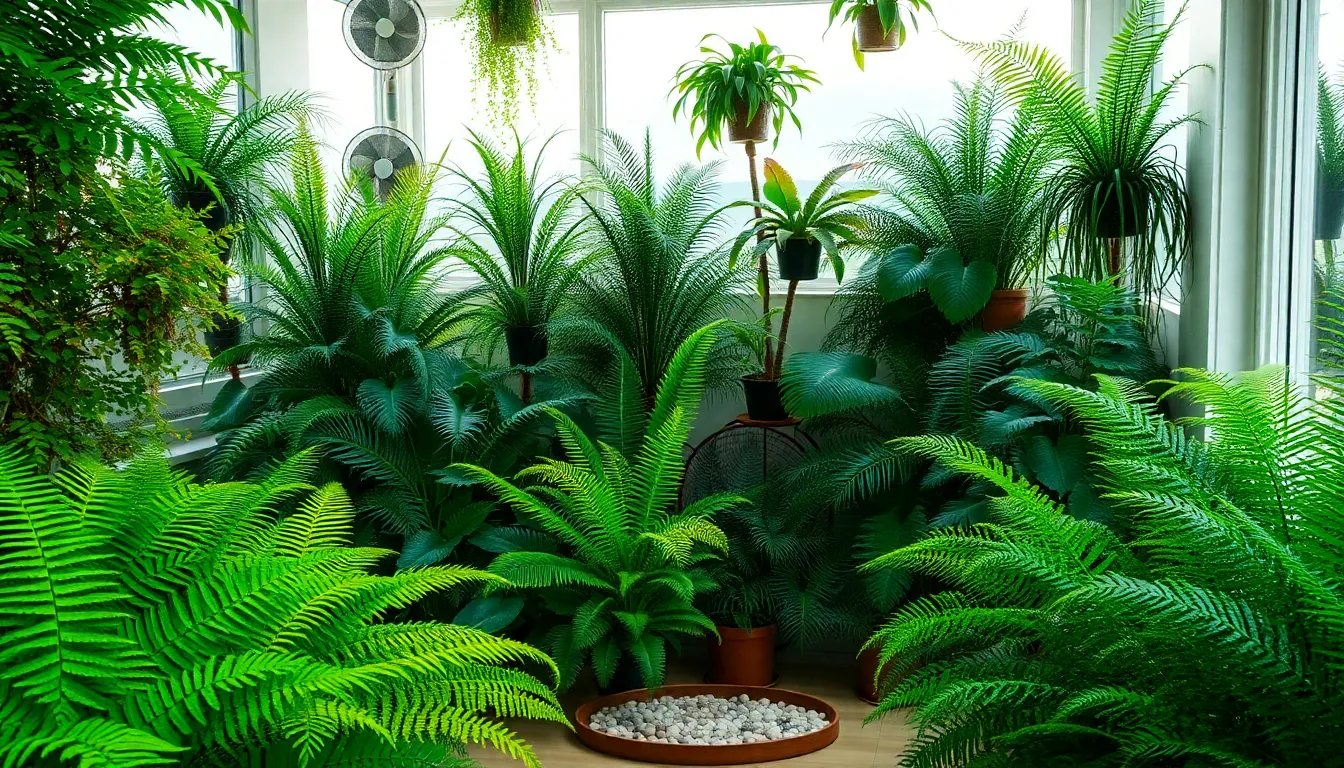
Creating an indoor fern garden room transforms any interior space into a lush sanctuary year round. We recommend positioning your fern garden near bright windows with filtered light while avoiding direct sunlight that can scorch delicate fern leaves.
Select Low-Light Fern Varieties
Blue Star Fern (Phlebodium aureum) thrives in lower indoor light conditions while adding stunning silver-blue foliage to your collection. This adaptable variety requires minimal maintenance and creates beautiful texture contrasts against darker green ferns.
Crocodile Fern (Microsorum musifolium) offers distinctive scale-like patterns on its leaves that mimic crocodile skin. We find this variety particularly resilient in indoor environments and perfect for adding unique visual interest to your fern garden room.
Austral Gem Bird’s Nest Fern (Asplenium hybrid) provides excellent structural variety with its broad, glossy leaves that form natural rosette shapes. These ferns adapt well to indoor conditions and create beautiful focal points when arranged at different heights throughout your space.
Combine different fern species to maximize visual diversity while ensuring all selected varieties share similar care requirements. This approach simplifies maintenance while creating ever-changing layered displays that enhance your indoor garden’s overall appeal.
Control Humidity and Air Circulation
Install humidifiers in your fern garden room to maintain the high moisture levels these plants require for optimal health. We recommend keeping humidity levels between 40-60% for most indoor fern varieties.
Place plants on pebble trays filled with water to create localized humid microclimates around each fern. This method increases ambient moisture without overwatering the soil and helps prevent dry air damage to fronds.
Ensure moderate air circulation using small fans positioned to gently move air throughout the room without directly blowing on plants. This prevents mold growth and pest issues while maintaining the humid environment ferns need.
Water consistently to keep soil moist but never waterlogged, as ferns prefer well-draining soil conditions. We check soil moisture regularly and adjust watering schedules based on seasonal humidity changes in your home.
Create Artificial Lighting Zones
Position grow lights or full-spectrum bulbs several feet above your ferns to simulate bright but indirect sunlight conditions. These artificial lighting zones ensure consistent light exposure throughout the year regardless of natural light availability.
Rotate ferns periodically to promote even growth patterns and prevent plants from leaning toward light sources. We recommend quarter turns every few weeks to maintain symmetrical frond development.
Arrange ferns at varying heights using plant stands, wall mounts, and hanging baskets to maximize space utilization and create layered lighting effects. This vertical approach allows multiple plants to benefit from single light sources while creating dramatic visual displays.
Check plants regularly for signs of insufficient or excessive light exposure, adjusting light positioning as needed to maintain healthy growth patterns. Proper artificial lighting zones ensure your indoor fern garden room thrives regardless of seasonal light changes.
Design a Japanese-Inspired Fern Garden
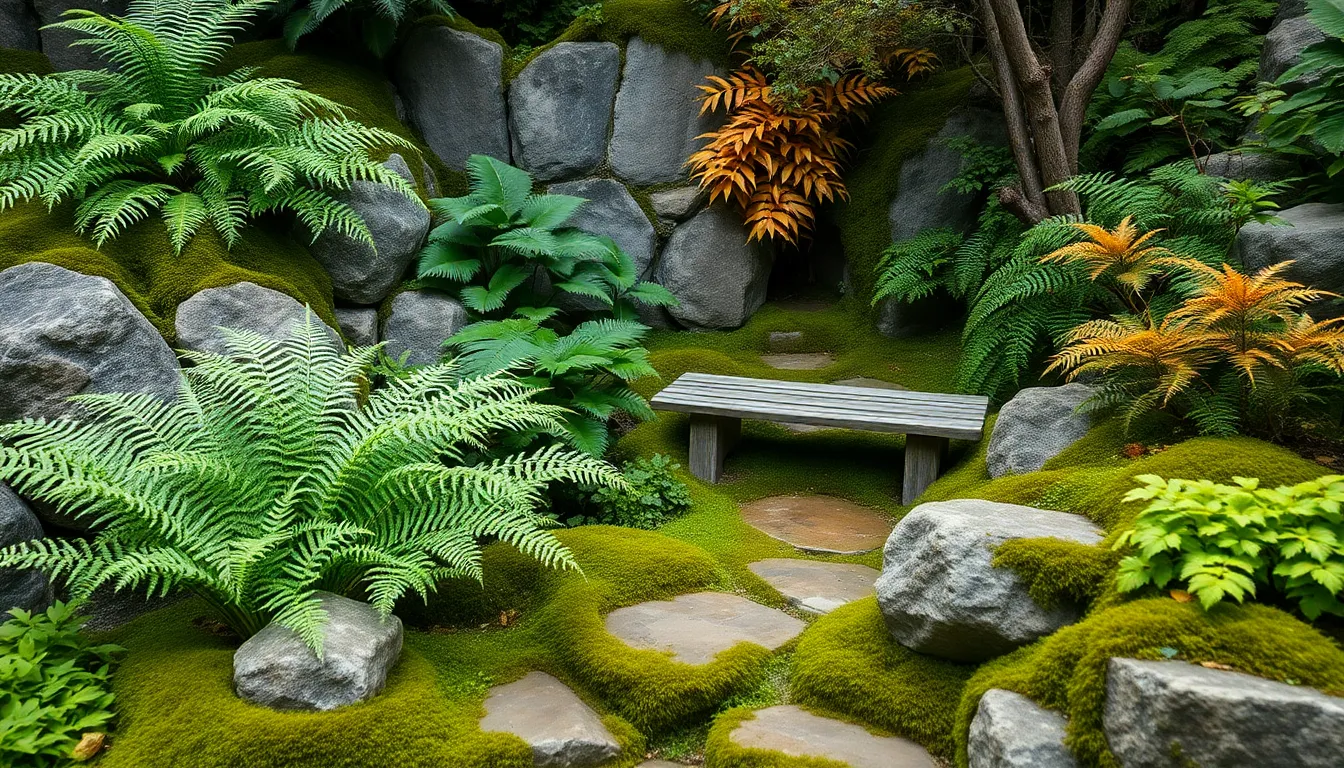
Transform your outdoor space into a serene meditation retreat with carefully chosen ferns and traditional design elements. Japanese garden principles emphasize harmony, balance, and seasonal beauty.
Choose Traditional Japanese Fern Species
Ghost Ferns create ethereal beauty with their delicate, translucent fronds that seem to float above the forest floor. We recommend planting them in clusters beneath larger trees where their subtle appearance can shine without competition from bolder plants.
Japanese Painted Ferns bring vibrant silver, purple, and green coloration that adds visual interest without overwhelming the garden’s peaceful atmosphere. Position these stunning specimens near pathways where visitors can appreciate their intricate color patterns up close.
Autumn Ferns provide seasonal transformation that perfectly aligns with Japanese aesthetic principles of appreciating nature’s changing cycles. Plant them strategically throughout your garden to create natural focal points that shift from bronze spring growth to deep green summer foliage.
Incorporate Zen Garden Elements
Stone Features anchor your fern garden with large boulders and carefully placed feature stones that create visual balance and natural meditation points. Select weathered stones with interesting textures and arrange them asymmetrically to maintain the organic feel essential to Japanese design.
Gravel and Pebbles represent flowing water or dry riverbeds while adding textural depth to planted areas. Rake fine gravel in flowing patterns around your ferns to create movement and guide the eye through different garden sections.
Moss transforms hard surfaces into soft, lush carpets that unify stone elements with living plants. Encourage moss growth on rocks and pathway edges by maintaining consistent moisture levels and providing filtered shade conditions.
Add Contemplative Seating Areas
Bench Placement encourages quiet reflection by positioning seating to frame the most beautiful garden views. We suggest placing simple wooden or stone benches where visitors can observe seasonal changes in your fern collection while remaining partially hidden within the industry.
Pathways guide movement through your garden using natural materials like flat stones or weathered wood planks. Create winding routes that reveal new perspectives of your fern plantings while maintaining the sense of discovery essential to Japanese garden experience.
Water Features enhance the serene ambiance with gentle sounds from small birdbaths, stone basins, or trickling fountains. Position these elements near seating areas where the sound of moving water can mask outside distractions and deepen the meditative atmosphere.
Establish a Fairy Garden Fern Landscape
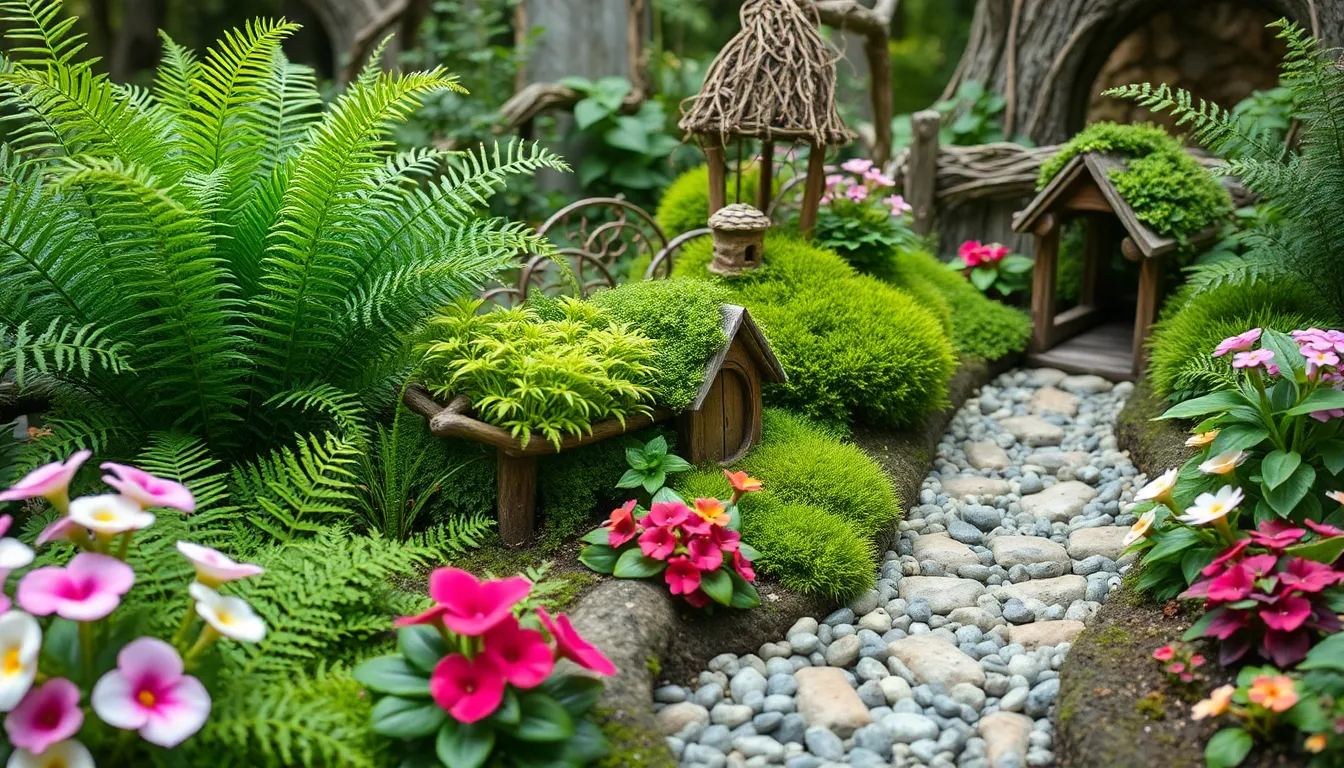
We can transform our outdoor spaces into enchanting miniature worlds by creating fairy garden fern landscapes that combine the natural beauty of ferns with whimsical touches. Ferns serve as ideal foundation plants for fairy gardens due to their low maintenance nature and ability to thrive in various climates and soil types.
Select Miniature Fern Varieties
Choosing compact fern species creates the perfect scale for fairy garden magic. Maidenhair ferns offer delicate, lace-like fronds that flutter gently in the slightest breeze, creating movement and texture in our miniature industry. Autumn ferns provide rich bronze and gold coloring that adds warmth and seasonal interest to fairy garden displays throughout the year.
Arranging these miniature varieties in small clusters maximizes their visual impact. We can position them around decorative elements like tiny benches, miniature houses, or small stones to create natural groupings. Boston fern cultivars work exceptionally well when planted near fairy doors or alongside miniature furniture pieces.
Selecting ferns with varying heights and textures adds depth to our fairy industry. Hart’s tongue ferns contribute glossy, strap-like leaves that contrast beautifully with the feathery fronds of smaller maidenhair varieties. We should plant these specimens in areas where they’ll receive filtered light and remain protected from harsh afternoon sun.
Add Whimsical Garden Accessories
Incorporating brightly colored ground covers enhances the magical atmosphere of our fairy fern garden. Succulents like hens and chicks or colorful flowers such as impatiens and begonias create vibrant splashes of color against the green backdrop of fern foliage. These additions provide visual interest while maintaining the low maintenance appeal that makes fern gardens so attractive.
Installing small scale garden features transforms ordinary spaces into extraordinary fairy realms. Tiny benches crafted from twigs and moss blend naturally with fern plantings while providing resting spots for imaginary garden visitors. Miniature bridges spanning small gaps between plant groupings create pathways that invite exploration and wonder.
Positioning decorative elements strategically throughout the garden creates focal points and visual flow. We can place miniature planters filled with tiny flowering plants among our fern collections to add pops of seasonal color. Fairy doors nestled against tree trunks or garden walls suggest hidden entrances to magical underground kingdoms.
Create Tiny Pathways and Structures
Building pathways using pebbles or small stones guides visitors through our fairy fern industry. We can arrange these materials in mosaic patterns that complement the organic shapes of fern fronds and create visual interest underfoot. River rocks and smooth pebbles work particularly well because they provide good drainage while maintaining the natural aesthetic we’re seeking.
Constructing miniature structures from natural materials maintains the organic feel of our fern garden. Twigs gathered from nearby trees can be assembled into tiny houses, gazebos, or arbors that blend seamlessly with the surrounding plantings. Moss collected from shaded areas adds authentic woodland character when used to cover these structures or create soft carpets beneath our ferns.
Designing these elements to complement our fern plantings ensures a cohesive garden theme. We should choose materials and colors that echo the natural tones found in fern foliage, from deep forest greens to silvery grays. Stone pathways can wind between fern clusters, leading to special features like miniature ponds or fairy circles created with small mushrooms or colorful stones.
Conclusion
Creating your perfect fern garden doesn’t have to be complicated. We’ve shown you many ways to transform any space into a lush green retreat that thrives with minimal effort.
Whether you’re drawn to the zen-like tranquility of a Japanese-inspired design or the playful charm of a fairy garden industry these versatile plants adapt beautifully to your vision. From dramatic vertical walls to peaceful water features each approach offers unique benefits for different spaces and lifestyles.
The beauty of fern gardening lies in its flexibility. You can start small with containers move indoors during harsh weather or create permanent outdoor sanctuaries that evolve with the seasons.
We encourage you to experiment with different combinations and let your creativity guide you. Your ideal fern garden is waiting to unfold.
Frequently Asked Questions
What are the benefits of growing ferns in shaded areas?
Ferns thrive in shaded spaces where other plants struggle, making them perfect for transforming dark corners into lush sanctuaries. They require minimal maintenance while providing year-round greenery and texture. Their ability to adapt to low-light conditions allows you to create beautiful gardens in previously unusable areas of your landscape.
Which fern varieties work best for woodland gardens?
Native woodland ferns like Christmas ferns, royal ferns, and lady ferns are ideal choices. These species naturally adapt to local conditions and require less maintenance. They create authentic forest-like atmospheres and can be grouped with similar soil preferences for easier care and more natural-looking displays.
How do I create a modern minimalist fern garden?
Focus on architectural fern varieties like Japanese Painted Fern and Tree Ferns for clean, structured looks. Use contemporary hardscaping elements with simple lines and group ferns strategically for maximum visual impact. Maintain consistency in design elements and avoid overcrowding to preserve the minimalist aesthetic.
What fern species are suitable for tropical garden designs?
Heat-loving varieties like maidenhair ferns, Boston ferns, and tree ferns work excellently for tropical themes. These species provide dramatic presence and lush foliage. Create humid microclimates using organic mulch, water features, and shade structures to support their growth in non-tropical climates.
How do I design a rock garden with ferns?
Select rock-dwelling varieties like Autumn Ferns, Lady Ferns, and Christmas Ferns for their adaptability. Position stones to ensure proper drainage and prevent waterlogged conditions. Create planting crevices that protect fern crowns while maximizing growing space for natural-looking stone and plant combinations.
What’s the best approach for vertical fern wall gardens?
Choose compact species like Maidenhair Ferns, Hart’s Tongue Ferns, and smaller Boston Fern cultivars. Install proper drip irrigation systems and use moisture retention materials. Layer ferns by light requirements: shade-loving varieties at bottom, partial shade in middle, and light-tolerant species at top.
How do I incorporate water features with ferns?
Use moisture-loving species like Autumn Fern, Ostrich Fern, Lady Fern, and Royal Fern around water elements. Place them strategically around pond edges in layered arrangements. Create bog garden sections to replicate wetland environments and manage moisture levels through proper irrigation systems.
What containers work best for portable fern gardens?
Select appropriately sized pots with excellent drainage for each fern variety. Group ferns by similar care requirements for easier maintenance. Choose materials that retain moisture while preventing waterlogging. Consider movable shade structures to enhance growing conditions and allow flexibility in garden placement.
How do I create an indoor fern garden room?
Position ferns near bright windows with filtered light and select low-light varieties like Blue Star Fern and Crocodile Fern. Control humidity using humidifiers and pebble trays. Install artificial lighting zones when natural light is insufficient and arrange plants at varying heights for visual appeal.
What elements make a Japanese-inspired fern garden?
Incorporate Ghost Ferns, Japanese Painted Ferns, and Autumn Ferns for authentic aesthetics. Add Zen elements like stone features, gravel pathways, and moss groundcover. Include contemplative seating areas and water features to create a meditative atmosphere that promotes tranquility and reflection.
How do I design a fairy garden with ferns?
Use miniature fern varieties like small Maidenhair and Autumn ferns for scale-appropriate displays. Arrange them around whimsical accessories like tiny benches and bridges. Build pathways with small pebbles and construct miniature structures from natural materials to maintain an organic, magical atmosphere throughout.

